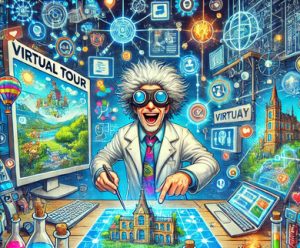
Last year in the post, Change the Routine Without Disrupting the Class – Take A Virtual Field Trip, I shared suggestions about taking students on virtual field trips. Since then I have been exploring different virtual spaces with students and my peers. It has been fun and rewarding. A few topics that we explored included:
- Respiratory system (Human Anatomy – Respiratory System)
- Electricity (What are Electromagnetic Waves?)
- Urban geography (World Cities)
- Climate change (Global Coral Bleaching Event)
- Student presentation (International Space Station)
- Future jobs (Career Exploration: Civil Engineer – Tom James)
Making a Virtual Tour for Your Class
After facilitating a few tour sessions, I started thinking about the possibilities of creating my own virtual tours. This included creating tours that were customized for my students. Tours could include learning objects related to their location, subject matter requirements and vocational aspirations. I took on this challenge by poking around the web and trying a few possibilities. The most suitable tool I could find was the Google Tour Creator. It allows anyone to produce suitable projects without much technical knowledge. The tours produced can be viewed using the Google Expeditions app through a VR viewer or on any browser without a viewer.
I created a tour based on the theme – public parks. You can try the Public Parks Vocabulary Tour to determine if it is a technology that might enhance your lessons. There are five scenes in this tour. These are City Park, Memorial Park, Beach Park, Winter Park and Playground. I used this as a pairs activity to introduce a City Spaces unit. They were responsible for learning the vocabulary and to identify and locate a park that they wanted to share with their classmates. Most of the students chose parks from their childhood.
Students were given the option of labeling their park with the Google Tour Creator or simply locating and sharing the park’s Street View location (web address) with their peers. For the ambitious students I created a “How To” sheet. A few students attempted to create a virtual tour. A future blog post will detail this experience.
Technology Required
A contemporary smart phone is recommended for its camera features. Other tools involved with creating Google Tours are freely available online:
- Google Poly Tour creator https://poly.google.com
- Google Maps Street View https://mapstreetview.com
- Copyright friendly image resource https://morguefile.com/photos
- Image editors https://pixlr.com/editor
Tour Creation Steps
To create your own virtual tour, first produce a virtual tour of Canada’s Parliament Hill by following the steps on the “How To” sheet. After you have confidence in this tool, start planning and creating your tour.
- Identify the course outcome(s) that is the foundation of this activity. (e.g.: getting around your neighborhood)
- Identify the topic of the activity. (e.g.: Neighborhood Places vocabulary)
- Define the name and scope of each scene. (e.g.: corner with view of a park and a few stores)
- Create a listing of vocabulary required in the activity. These will be the specific point of interest in each scene. (e.g.: grocery store, school)
- Locate scenes on Google Maps Street View and bookmark them. Ensure that there are enough points of interest in the panorama.
- If scenes are not available, go to the place and use your smart phone to capture a panorama image.
- Upload the panorama image to Google Maps Street View.
- Ensure that all images have appropriate copyright citations.
- Ensure cultural sensitivities are considered with each scene.
- Create the text copy for each scene and point of interest.
- If the text is copied from an online source, cite the source.
- Open the Google Tour Creator.
- Assemble all tour elements.
- Scenes
- Points of interest
- Pop up images
- Text
- Test the tour.
- Publish and share the tour.
Final Thoughts
If you want to see more samples go to https://poly.google.com. The potential for language learning with this technology is unlimited. Possibly, additional functionality such as media clips and interactive assessment tools will be integrated to make these more engaging learning events. At this time however, creating a virtual tours takes time and a fair amount of crafting.
It would be appreciated if you shared any tours that you create with the TESL community. Kindly share links to your tours below. Looking forward to seeing them.

This is a great idea! Thanks for sharing.
Thanks for the kind words Angela. I hope a few instructors try it out this year.
I hope a few instructors try it out this year.
Wow, I am doing a workshop at the conference on making stuff, but this idea blows my mind. I’m retired now. I wish I could have done this when I was teaching. Maybe you should do this at the conference if you aren’t already doing it.
John, it is nice to hear positive and feedback. Thank you! I am running a session on this at TESL Ontario this year. In January and February I am running a free 5 week online course via the TESOL Electronic Village Online.
TESL Ontario Session: Student Virtual Tours
Summary : Google Expeditions has extended its functionality to allow users, in our case students, to create their own virtual tours using the app Tour Creator. In this session, participants will become familiar with virtual tours and observe a student generated tour of their neighborhood. Student enhance their vocabulary, creativity and gain confidence through sharing their virtual tour with their peers.